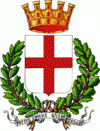Vercelli (Provincia di Vercelli)
 |
The city is situated on the Sesia River in the plain of the Po River between Milan and Turin. It is an important centre for the cultivation of rice and is surrounded by rice paddies, which are flooded in the summer. The climate is typical of the Po Valley with cold, foggy winters (0.4 °C in January) and oppressive heat during the summer months (23.45 °C in July). Rainfall is most prevalent during the spring and autumn; thunderstorms are common in the summer.
The languages spoken in Vercelli are Italian and Piedmontese; the variety of Piedmontese native to the city is called Varsleis.
The world's first university funded by public money was established in Vercelli in 1228 (the seventh university founded in Italy), but was closed in 1372. Today it has a university of literature and philosophy as a part of the Università del Piemonte Orientale and a satellite campus of the Politecnico di Torino.
Vercellae (or Vercelum) was the capital of the Libici or Lebecili, a Ligurian tribe; it became an important municipium, near which Gaius Marius defeated the Cimbri and the Teutones in the Battle of Vercellae in 101 BC.
The imperial magister militum Flavius Stilicho annihilated the Goths there 500 years later. It was half-ruined in St. Jerome's time (olim potens, nunc raro habitatore semiruta (1, 3.1)). After the Lombard invasion it belonged to the Duchy of Ivrea. From 885 it was under the jurisdiction of the prince-bishop, who was a Count of the Empire.
It became an independent commune in 1120 and joined the first and second Lombard leagues. Its statutes are among the most interesting of those of the medieval republics. In 1197 they abolished the servitude of the glebe. In 1228 the University of Pavia was transferred to Vercelli, where it remained until the fourteenth century, but without gaining much prominence; only a university school of law has been maintained.
In 1307, Fra Dolcino, the leader of the Dulcinians was tortured and burned at the stake.
During the troubles of the 13th century, it fell into the power of the Della Torre of Milan (1263), of the Marquesses of Monferrato (1277), who appointed Matteo I Visconti captain (1290–1299). The Tizzoni (Ghibellines) and Avogadri (Guelphs) disputed the city from 1301 to 1334. The Guelphs were expelled several times, enabling the Marquess of Monferrato to take Vercelli (1328), which voluntarily placed itself under the Viscount of Milan in 1334. In 1373, Bishop Giovanni Fieschi expelled the Visconti, but Matteo reconquered the city. Facino Cane (1402), profiting by the strife between Giovanni Maria and Filippo Maria Visconti, took Vercelli, but was driven out by Theodore II of Montferrat (1404), from whom the city passed to the dukes of Savoy (1427).
In 1499 and 1553 Vercelli was captured by the French, and in 1616 and 1678 by the Spaniards. In 1704 it sustained an energetic siege by the French, who failed to destroy the fortress, after which it shared the fortunes of Savoy. In 1821 Vercelli rose in favour of the Constitution.
Map - Vercelli (Provincia di Vercelli)
Map
Country - Italy
 |
 |
| Flag of Italy | |
Italy was the native place of many civilizations such as the Italic peoples and the Etruscans, while due to its central geographic location in Southern Europe and the Mediterranean, the country has also historically been home to myriad peoples and cultures, who immigrated to the peninsula throughout history. The Latins, native of central Italy, formed the Roman Kingdom in the 8th century BC, which eventually became a republic with a government of the Senate and the People. The Roman Republic initially conquered and assimilated its neighbours on the Italian peninsula, eventually expanding and conquering a large part of Europe, North Africa and Western Asia. By the first century BC, the Roman Empire emerged as the dominant power in the Mediterranean Basin and became a leading cultural, political and religious centre, inaugurating the Pax Romana, a period of more than 200 years during which Italy's law, technology, economy, art, and literature developed.
Currency / Language
| ISO | Currency | Symbol | Significant figures |
|---|---|---|---|
| EUR | Euro | € | 2 |
| ISO | Language |
|---|---|
| CA | Catalan language |
| CO | Corsican language |
| FR | French language |
| DE | German language |
| IT | Italian language |
| SC | Sardinian language |
| SL | Slovene language |






















